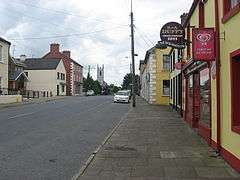Shercock
| Shercock Searcóg | |
|---|---|
| Town | |
|
St. Patrick's Church, Shercock. | |
 Shercock Location in Ireland | |
| Coordinates: 53°59′40″N 6°53′48″W / 53.9945°N 6.8968°WCoordinates: 53°59′40″N 6°53′48″W / 53.9945°N 6.8968°W | |
| Country | Ireland |
| Province | Ulster |
| County | County Cavan |
| Time zone | WET (UTC+0) |
| • Summer (DST) | IST (WEST) (UTC-1) |
| Irish Grid Reference | H720057 |

Shercock (Irish: Searcóg, meaning "young love") is a small town situated in the east of County Cavan, Ireland. The current population of the town is 1,032 people with almost triple this amount in the surrounding areas.
Shercock is located at the intersection of the R162 and R178 regional roads. The town is located on the shores of three lakes - Lough Sillan, Steepleton's Lake and Muddy Lake. Lough Sillan is the largest of the three covering some 162 hectares.

History
The town was founded in the early 17th century as a Plantation village to accommodate mainly Presbyterian British settlers who colonised this part of County Cavan. Usually these new settlers gave their towns English or Scottish names - near neighbours are Kingscourt, Cootehill, and Bailieborough - but the existing Irish names were maintained in Shercock. The modern Irish language name is Searcoig or Searcog; either name may be translated literally as "young love", and there is no reason to believe that the name has changed in the last 400 years. Possibly the straitlaced and God-fearing Scots of the early 17th century did not realise the risque implications of the name they inherited from the local Gaelic population.
Equally strangely, the local townlands in this northern Protestant enclave almost all retain their ancient Gaelic names. For example, the townland of Lecks, on the Kingscourt road on the outskirts of Shercock, has been so named for a thousand years because of the flat-slabbed rocky landscape (leac is the Irish word for a flagstone). By contrast, townlands in the predominantly Gaelic west of Ireland very often have distinctly English names.
By the mid-19th century the village and immediate area had a population of about 5,000. However, the great famines and subsequent emigration severely affected the county of Cavan, reducing the population by 50% between 1841 and 1891.
Industry
The area is "Drumlin Country", being a landscape of small hills and lakes formed at the end of the last ice age. County Cavan borders County Fermanagh and County Monaghan. Together, they form the colloquially named, "Drumlin County". Shercock lies on the border between County Cavan and County Monaghan.
The Shercock area's main industry for nearly 300 years was the growing of flax for linen-making. One townland just outside Shercock is named Miltown, after the flax mill which lies ruined at its center. The industry gradually died away with the decline of the linen industry in northern Ireland.
Nowadays the town is an attractive and prosperous place with some light industry and a small number of tourists based mainly on water sports and angling. Lough Sillan, on the edge of the town, is a noted coarse fishing lake with thousands of metres of shore for free all-year angling. Annaghieran lake is another nice spot offering a car park and is only 1 mile from town, its well known for providing Roach and Bream.[1] There are several smaller lakes within easy reach of the town.
One of the industries which brings a large amount of employment to this small town is Manor Farms and Carton Bros. Chicken factory which employs over 800 people and sources chicken from 160 local chicken farms.
Transport
Sillan Tours Limited provides daily bus connections from Shercock to Kingscourt, Navan and Dublin.[2] Bus Éireann route 166 links Shercock to Cavan, Carrickmacross and Dundalk on Mondays, Wednesdays and Fridays only.[3]
Arts
The annual Shercock Drama Festival one of the highlights of the cultural calendar in the region and patrons flock to the venue to enjoy the unique atmosphere. It celebrated its 25th year in 2012, for which it proudly held the All Ireland Finals. The festival usually takes place in March each year with drama groups from around the country participating in the event. It takes place in St Patrick's Hall.
People
- The family of playwright Richard Brinsley Sheridan (The School for Scandal) had an estate in Shercock; Lewis' Topographical Dictionary of Ireland cites Shercock as Sheridan's birthplace, though most sources say Dublin.
- Patrick Kavanagh's 1948 novel Tarry Flynn is nominally set in the countryside around Shercock. although based on characters from his native Inniskeen.
- The great-grandfather of U.S. Rep. John Murtha, also named John Murtha, was born in Shercock c. 1858, moving to the United States in 1882.
- John McCaul - comedian and writer of the recently published 'Ode to Corduff - A poetic Odyssey'.
- Brendan McCahey - Voice of Ireland singer
External link
- Shercock Drama Festival Official Website
- Shercock Local Community Website
- Shercock Credit Union Website

